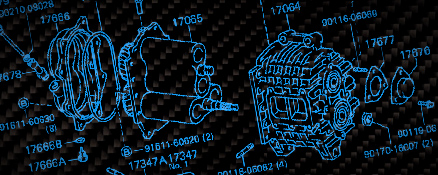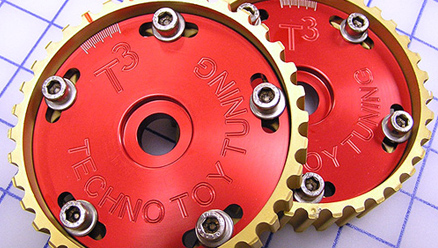
The guide returns for part three in our continuation of all things modified on your AE86. In the next few installments we are going to be looking at boosting your AE86, starting with the most commonly boosted engine: the 4A-GZE!
WHICH GZE IS WHICH?
Since the introduction of the 4A-GZE in the AW11 MR2 back in the mid 80’s, the ‘GZE has been Toyota’s only small capacity forced-induction engine. Along with the 20 valve 4A-GE, it is the most popular option after the standard 16v conversion.
Since its introduction there have been a number of changes to the original AW11 GZE. When updated for the front wheel drive AE92 and AE101 Levins and Truenos, the most important change was from the utilisation of an Air Flow Meter (AFM) to the more accurate and fuel efficient Manifold Absolute Pressure (MAP) sensor. This occured first on the AE92 version of the 4A-GZE.
The earlier AW11 GZE’s used a distributor for spark and the early AE92 variation now used a coilpack and crank angle sensor setup. The use of this coilpack based ignition system continued up until the GZE was discontinued in 1996/97.
Probably the biggest change in the later AE92’s was the change from the ‘bigport’ head to the much more efficient and TVIS-less, ‘smallport’ head. After the switch the head design worked so well it wasn’t again changed until the production of the 4A-GZE ended. With this change of head design there was also a small compression increase: Up from 8:1 for the bigport, to 8.9:1 for the smallport.
With the change in heads and obviously also the ECUs, power increased for the GZE from 145hp (105kw) for AW11 up to 165hp (121kw) for AE92 to finally 175hp (125kw) for the AE101 version. The later model smallport GZE’s increase in power is due to using a smaller pulley in the supercharger.
The other biggest change for the smallport GZE was its strength. 4A-GZE’s were already known for their over engineering by Toyota with semi-forged and ceramic coated pistons in the AW11 GZE, along with the top mount intercooler.
But with the update to smallport heads Toyota went the extra mile and fitted forged teflon ceramic coated pistons, oil squirters to cool the undersides of the pistons, a strengthened crank, and the beefiest rods ever fitted to a 4A from the factory.

As you can see the AE92 smallport GZE rods dwarf the factory NA smallport and AE101 GZE rods (show in the middle in the above pic) and are almost twice the size and thickness, such is the indestructibility of the AE92 smallport GZE, another reason for its huge popularity and success.
The AE92 bigport and AE92 and AE101 smallports were all exclusively FWD drive engines and when fitted to an AE86 (or any other RWD car for that matter) it will need to be converted to a RWD configuration. This means the water lines will need to be re-routed, and for the smallport versions (AE92 and AE101) a cut and shut of the intake manifold to make it face toward the front of the car and not the rear. FWD to RWD conversions have been covered many times before so we don’t need to go into detail here.
BOOOOOOOOOOOOOOOOOOOSSTTT!!!!!!

So, now that you have your GZE fitted and running what next? First eat an aptly named chocolaty treat to celebrate this momentous occasion and then second: upgrade that puny throttle body!
The factory throttle body size is 45mm for a 4A-GZE and 60mm for the NA 4A-GE, so I think you know what to do there… raid that parts bin!
If you haven’t already fitted a decent exhaust system, now is the time. Like its NA brethren, the exhaust requirements of the GZE are very similar and would require no bigger than a 2.5″ (60mm) exhaust system, along with a decent set of headers. The headers don’t need to be long fancy primary’s like you see on some crazy hard tuned NA cars, so a decent equal length 4-1 or 4-2-1 will do the trick just fine.
You may be thinking that it has boost, it needs a big ass drain pipe exhaust! Not so! Because the supercharger acts like a big pump forcing air in the cylinders, it does so at a very linear rate not reaching maximum boost until much higher in the revs.
Unlike turbos where at a certain RPM it reaches maximum boost, the supercharger provides a linear torque curve all the way to redline, much like an NA engine. The only difference it does it with a major torquey kick in the pants! So that said, a fairly mild exhaust system is all that is required.
COOL OFF

Now if you wish, you can still use the top mount intercooler in the OEM position and have a bonnet scoop like pro stock drag car or you can run the standard intercooler in a front mount position.
Using the standard intercooler in a front mount position will be fine to get it up and running. If you going to fit something in a front mount position it will be a better idea to change to a decent aftermarket intercooler or larger OEM intercooler such as a EVO or Skyline intercooler. However, with the number of readily available aftermarket intercoolers and them being priced so cheap, it’s much easier to opt for an aftermarket core. Fitting the intercooler in the front mount position also increases it ability to cooler the charged air, creating denser cooler air for better consumption.
Now why would you want to fit a bigger intercooler than standard seeing as Toyota deemed it fine?
Well with a larger core, you get cooler and denser air for better power production. Also if you want to increase the boost pressure, use a bigger supercharger (SC14 anyone?) or maybe fit a turbo, these things all produce heat and will require a larger ‘cooler to compensate.
Well if you have already fitted a larger core and all the pipe work it’s much easier to adapt to your new set up as you wont have to go out and purchase a new core and plumbing to suit each change you make!
Be aware though you don’t want to go *too* big on the cooler size as the GZE factory ECU doesn’t play nice with huge manifold pressure irregularities. IE dont run out and buy a massive trust drag cooler when a mild 400x300mm cooler will work much better for your purposes. Overkill = Bad.
STILL NOT FAST ENOUGH HUH?

There are a number of ways to increase the boost pressure from the GZE, either via fitting a larger crank pulley or smaller supercharger pulley. The smaller supercharger pulley is probably the most common, but as the smallport came with a smaller pulley factory its not as easy to replace the smallport pulley with a smaller again sized pulley.
Certainly fitting a smallport pulley to a bigport engine will increase pressure on the big port engine, but again it may be cheaper and easier to find, or have made, an aftermarket pulley instead.
NEVO was and is probably the most common pulley kit for any GZE, utilizing a smaller pulley on the supercharger and slightly larger crank pulley to increase the supercharger speed and boost pressure. NEVO has since stopped production of their pulleys, but any machine shop should be able to make one for you easy enough.
Nowadays the most common way to increase and probably the best way is to run a larger crank pulley, and use the standard size supercharged pulley as this again will still increase boost pressure but also takes a lot of the strain off the smaller supercharger pulley as the revs increase.
BUILT FOR BOOST

Like its NA brother, adding camshafts works well to increase power for the 4A-GZE. The factory camshaft duration is 232° deg with 7.1mm lift (same as smallport cams), which is a good boost cam, meaning it keeps boost pressures in the engine instead blowing backwards into the intake manifold.
The normal aftermarket durations for NA cams (256-290° deg) work very well with the GZE, but you want to select the cams with the largest amount of lift to take advantage of the boost the supercharger provides. lift of at least 7.8mm or higher is best.
A quick google search shows that the HKS catalogue has the largest duration for off-the-shelf cams, and the other manufacturer like TIGHE, WADE and KENT can make custom spec cams for you in almost any duration and lift.
Cams will provide a massive mid range to top end shove, but you lose a bit of torque below 3000-3500rpm. But anyone who has driven with a 4A-GE equipped, knows your rarely below 3000rpm!
Yes, all this can be run with the standard ECU! The 4A-GZE ECU is actually a fairly forgiving bit of gear: as long as you have a constant positive pressure in the intake manifold the ECU usually reacts fairly well to most modifications.
Fitting a programmable ECU will make things so much better, and again allows for more power production. one of the best things about the programmable ECU’s is most recent additions come with ANTI-LAG and BOOST CONTROL. While not overly necessary with a supercharger, they may come in handy if you decide to upgrade to something else in the future….
RAGE AGAINST THE MACHINE

Unfortunately, one of the possible major failure points after fitting a GZE engine is the T50 gearbox and T-series differential.
The T50 gearbox is all well and good for NA power, but when you add the amount of torque the GZE produces through a T50 you’re going to break something.
This goes for the T-series rear end as well: It’s great for NA power, but can break after too much torque and abuse.
That’s not to say a T50 and T-series wont handle the power, because it will contain it for a good amount of time. It has been proven on number of 4A-GZE powered cars that T50 and T-series equipped cars can cop a flogging with boost and keep on keeping on! But it will always only be a matter of *when*, not so much *if* you break something. When you do break something you will want to look towards a stronger unit such as a W5x series gearbox and at a minimum Hilux diff.
More of this will be covered in another edition of our tuning guide about drive line upgrades.
THE RIGHT HEAD FOR THE JOB
Common consensus says the GZE works best with the original 16V head and single throttle body intake manifold. A few people have tried to fit a 20V head with quads, as the 20v head flows much more, but have had little success. The main reason is that the quads won’t really work under the vacuum the supercharger creates at idle, and the way it increases in positive pressure as the revs rise.
You could if you wanted to create a single throttle intake manifold for the 20v head, to run with the supercharger. But the benefits are very minimal at best, and are easily out done by a simple turbo set up instead. Bang for buck is what most forced-induction drivers are after and this is the key ideal when considering this setup.
That’s it on the 4A-GZE and superchargers but stay tuned for the fourth installment of the HR AE86 Tuning Guide where we will cover positive boost in more detail: 4A’s + Turbos!




4 Responses to AE86 Tuning Guide: Dial Z For Supercharged!